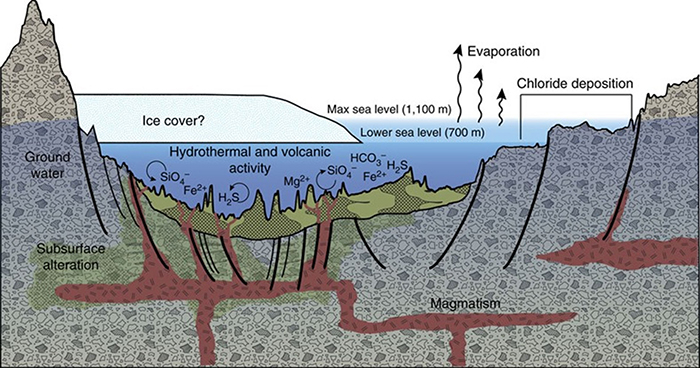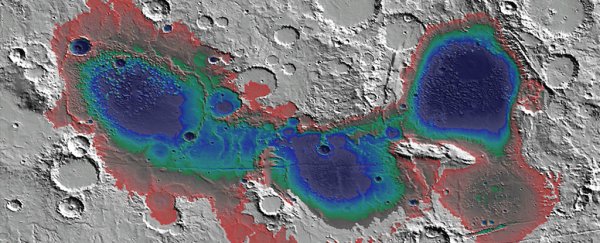Mars may be an arid wasteland today, but that wasn't always the case – and scientists have discovered evidence that a huge sea existed on southern Mars some 3.7 billion years ago, filled with hot springs pumping out water packed with minerals.
What's more, experts think this hydrothermal undersea activity matches what was happening on Earth at the same time, potentially giving us clues about how life began on our own planet.
According to the international team of researchers behind the study, this combination of rocks, water, nutrients, and heat could have sparked life into being on Mars as well, but has just as much to teach us about the origins of life on Earth.
"Even if we never find evidence that there's been life on Mars, this site can tell us about the type of environment where life may have begun on Earth," says one of the team, Paul Niles from the NASA Johnson Space Center in Houston.
"Volcanic activity combined with standing water provided conditions that were likely similar to conditions that existed on Earth at about the same time – when early life was evolving here."
 How the sea of Eridania may have looked and worked. Credit: NASA
How the sea of Eridania may have looked and worked. Credit: NASA
The new analysis is based on images of a basin on the south of Mars called Eridania, where the NASA Mars Reconnaissance Orbiter (MRO) and its Compact Reconnaissance Spectrometer for Mars (CRISM) spotted large deposits of minerals on the surface.
The patterns and chemical composition of these deposits suggest that once upon a time hot springs, a huge ocean, and rocks heated up by volcanic activity were present, the researchers say.
And we're talking about a seriously big sea: maybe 210,000 cubic kilometres (50,380 cubic miles) of water, more than all the other lakes and seas on ancient Mars combined, and nine times more than all the water in the Great Lakes of North America.
Over billions of years, the Martian atmosphere and all of its water was stripped away by a barrage of solar winds, without the protection we get from the Earth's magnetic field. These new results give us an exciting window into the past.
"This site gives us a compelling story for a deep, long-lived sea and a deep-sea hydrothermal environment," says Niles.
Its potential to birth life doesn't just apply to the Red Planet though: "It is evocative of the deep-sea hydrothermal environments on Earth, similar to environments where life might be found on other worlds – life that doesn't need a nice atmosphere or temperate surface, but just rocks, heat and water," adds Niles.
We're not sure whether or not this hydrothermal activity could be one of the origins of life on either Mars or the Earth yet – though life has subsequently flourished on our own planet and has yet to be seen on Mars.
What makes the finding so valuable to scientists is that evidence of this sort of underwater activity here on Earth has been poorly preserved and is difficult to study, so the Martian landscape could fill in a few of the blanks.
Right now the idea that life on Earth began in the chemical reactions sparked off by underwater springs is one of the best hypotheses we've got. Another idea is that the most basic forms of life began to grow from meteorite fragments in small, warm ponds on the surface of the planet.
With help from the Martian data we might be able to learn more about the truth of the origins of life on Earth – as well as on Mars and the other planets and moons in our Solar System, such as Saturn's icy moon Enceladus.
The Reconnaissance Orbiter will continue to keep a close eye on Eridania, and it could be a prime candidate for further exploration in the Mars missions of the future as we look for more evidence for life on Mars.
"Ancient, deep-water hydrothermal deposits in Eridania basin represent a new category of astrobiological target on Mars," conclude the researchers.
The research has been published in Nature Communications.
